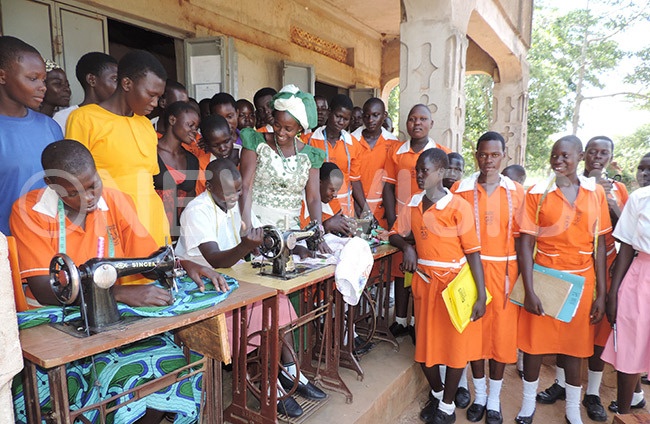Achieving the demographic dividend in Uganda: What should be done?
A country’s age structure is more important than its population size or growth rate. This is because people’s effects on the economy vary depending on their level of productivity, which in turn is affected by their age.
YOUTHS|DEVELOPMENT
It is no secret that Uganda has one of the youngest and most rapidly growing populations in the world. It currently has the second youngest population in the world with over 78% below 30 years, second only to Niger's 83%. The youth population in Uganda comprises of both the educated/skilled and the unskilled living in both the rural and urban areas.
Such a young population can be a great resource or rather a huge burden as regards national development. A country's age structure is more important than its population size or growth rate. This is because people's effects on the economy vary depending on their level of productivity, which in turn is affected by their age. It therefore matters most that a nation like Uganda makes its priorities right to harness what is referred to as the demographic dividend.
According to Dr Fred Muhumuza, an economist, demographic dividend refers to the growth in an economy that is the resultant effect of a change in the age structure of a country's population.
"This change in age structure is typically brought about by a decline in fertility and mortality rates. The demographic dividend is therefore the economic benefit a society enjoys when
fertility and mortality rates decline rapidly and the ratio of working-age adults significantly increases relative to young dependents," he explains.
 Most youths in Uganda shun agriculture for white-collar jobs but engagement in such projects as poultry keeping would contribute to the national economy while simultaneously improving their livelihoods.
Most youths in Uganda shun agriculture for white-collar jobs but engagement in such projects as poultry keeping would contribute to the national economy while simultaneously improving their livelihoods.
Thus, the dividend refers to the benefits that come out of efforts that reduce the population growth rate, having empowered the current population through education, good health, and an economy that creates opportunities both in employment and self-business start-ups.
"Eventually you have more working people than dependents. We therefore need to invest in health, giving proper skills, creating opportunities through faster economic growth, and trading opportunities within and outside the country to gain this dividend as a country," Muhumuza opines.
Prof. Augustus Nuwagaba, an international consultant on economic transformation also says that the major tool for Uganda to harness demographic dividend is building stronger human capital.
According to him, countries that enjoy demographic dividend have the qualitative element of a population that is composed of great human capital and an economic framework that guarantees effective demand.
It also has an attitudinal component where the people love to work, innovate and have the capacity to buy. "For example in China, almost every citizen has capacity to produce, innovate, and buy. This is an asset for stimulating aggregate demand," Prof. Nuwagaba says.
He holds the view that Uganda has the capacity to enjoy a demographic dividend but needs very good strategies for this to happen.
 Uganda's unemployment levels are so high that such lines of job seekers are a common sight where any opportunities arises
Uganda's unemployment levels are so high that such lines of job seekers are a common sight where any opportunities arises
Current state of affairs in Uganda
According to the Uganda National Planning Authority (NPA), Uganda's population change; vis a vis development is still in discord. One of NPA's publications states that over the past three decades, child mortality in Uganda has declined steadily while fertility rates have remained high.
"This imbalance has resulted in high population growth and a youthful population with a high child-dependency ratio. The population grew from 9.5 million in 1969 to 35.3 million in 2013," the document reads in part.
I should be noted that Uganda's population is currently estimated at 44.3 million with a median age of 15.9 years and according to UN projections will grow to 83 million by 2040.
As noted in the 2008 National Population Policy and Vision 2040, the high child-dependency ratio is a major barrier to social transformation and development in Uganda. A large average family size makes it difficult for families and the government to make the requisite investments in education and health that are needed to develop high-quality human capital and achieve a higher level of socioeconomic development.
Savings are low because parents spend most of their income on their children's basic needs and it is difficult for the economy to create enough high-quality jobs for the rapidly growing youthful labour force. This simply states that most of Uganda's youth are not contributing to the nation's economy.
Asked whether Uganda can achieve a demographic dividend with such trends, Muhumuza says, "Not when the current strategies are just political talk with no detail and commitment to get the right policies and implement them. We have achieved a reduction in the fertility rate, (number of children per woman) from 6.9 to about 5.4 over the last decade or so but have not yet improved our education, health systems, clear family planning measures and economic growth targets to get the dividend actualized within the next 25 years. It will take more effort than I see."
Under-education as a challenge to development
In Uganda today, young people are more likely to have easy access to education compared to those in the earlier years. That can be regarded as a step in the right direction.
But according to the school-to-work transition survey (SWTS) carried out by Uganda Bureau of Statistics in 2015, as much as 68% of young people out of school had only completed primary education and only 3.4% had completed tertiary education.
"The level of leaving school early remains high; about half (51%) of young persons left school early with the majority (almost 59%) being young females. Results also showed that too many young Ugandans were leaving school early to take up work," reads a statement in the report.
The SWTS results show that as high as 71% of young working Ugandans were undereducated for the work they do. These are concentrated in skilled agriculture, forestry and fishery work, plant and machine operators, and assemblers and craft and related trades work. Under education can have a negative impact on the productivity of the worker and thus on the output of the place where they work and on the young worker's sense of economic security.
 Market relevant skills much be passed on to youths early enough if Uganda is to achieve demographic dividend
Market relevant skills much be passed on to youths early enough if Uganda is to achieve demographic dividend
Case of East Asian countries
The dividend has been most successfully achieved in East Asia in countries including Hong Kong, Singapore, South Korea and Taiwan. According to Elizabeth Madsen, a Senior Technical Advisor on the USAID Health Policy Project, economists estimate that between 1965 and 1990, demographic changes accounted for about one-third of the economic expansion in East Asia, when per capita incomes grew over six percent annually.
These four ‘East Asian tigers' have consistently maintained high levels of economic growth since the 1960s fuelled by exports and rapid industrialization and have joined the ranks of the world's richest nations.
Hong Kong and Singapore are among the biggest financial centres worldwide, while South Korea and Taiwan are important hubs for global manufacturing of automobile and electronic components as well as information technology.
Uganda's Challenges
"Uganda has implementation paralysis and that is a big weakness that curtails harnessing demographic dividend," Prof. Augustine says. He explains that this is majorly reflected in budgets that are not aligned to national development plans.
"You have also often seen situations where government borrows money for certain projects but this money arrives when the projects haven't reached implementation stage. The funders on their part expect their interest to be paid as per agreement and therefore Uganda ends up losing out. That is a huge deterrent to achieving a demographic dividend," Prof Nuwagaba adds.
More so, Prof. Nuwagaba accuses Ugandans of having a very bad attitude towards work and that means very few people are productive. "In countries like Vietnam and even our close neighbours, Rwanda, people work with their nation at heart. They collectively engage in growing their economy and this has set such countries on the right path to development."
On another note, Uganda still has a high fertility rate. "Uganda's current total fertility rate is 5.4 children per woman and that is still very high. This only means that such a population dilutes the gains of economic growth. If the economy is growing at 4.5% and the population growth rate is 3% that is dangerous. We cannot realise a demographic dividend if many people are being born. Population growth should always be a quarter of the economic growth rate for the economy to cater for the population. You can't achieve middle income status with such trends," Prof. Nuwagaba elaborates.
 Natural talents like in art and design must be nurtured for youths to earn and contribute to the national economy
Natural talents like in art and design must be nurtured for youths to earn and contribute to the national economy
What should be done?
Prof. Nuwagaba says Uganda needs to improve its education sector to provide market relevant training for its young population. This he says will enable Ugandans to innovate and create employment hence enabling the economy to grow at a much faster rate than population.
He also opines that improving production especially through setting up widespread irrigation infrastructure will enable many more Ugandans to produce for commercial purposes. This translates into improved household incomes and if this is sustained, Uganda can enjoy her demographic dividend.
Prof. Nuwagaba also states that good economic policies to guarantee hard work should be made. "Countries like South Korea were just like us not very many years ago. But through good policies, they built attitudes of hard work and innovation and are currently enjoying their demographic dividend," he says.
He also advises that government should apply radical policies like export promotion and limited importation. "Initiatives like By Uganda, Build Uganda (BUBU) are good but the fact is that most Uganda made products are expensive in comparison to imported alternatives. This is due to the fact that the costs of production like electricity in Uganda are so high," Prof. Nuwagaba explains.
According to the World Bank, creating quality jobs is a major policy challenge for Uganda. "With an unemployment rate of below 5%, it is apparent that Ugandans are working hard, but too many of them are involved in low productivity formal and informal sector activities. This hinders the structural transformation required to drive Uganda's economic development. The government needs to implement proper policies and the creation of a greater number of productive employment opportunities to ensure an inclusive growth that will enable Uganda to fulfill its aspiration of becoming a stable, integrated middle income country," reads one of the bank's reports on Uganda.
The World Bank also suggests that creating better jobs on the farm and promoting agribusiness are critical to improving productivity. "Agriculture is the core of the economy and the primary source of employment, engaging 73% of the country's labor force primarily in the rural areas. Exploiting agribusiness opportunities and improving farmers' access to markets, credit and lower cost inputs, better land policies such as expedited issuance of titles, extension of research and advisory services will increase productivity and create better quality rural jobs."
In light of these pointers, a lot more should be done to steer Uganda into the right direction and pace for the dream of a demographic dividend to be realised.
 Youths making furniture at their workshop in Nsambya
Youths making furniture at their workshop in Nsambya
RELATED TO THE STORY
SmartUp project launched in Kawempe